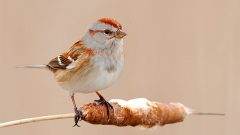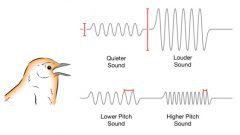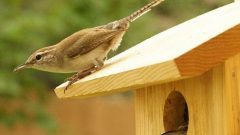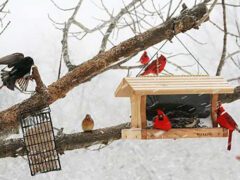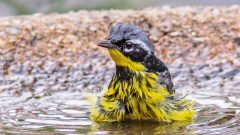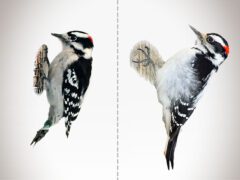Eastern Towhee Similar Species Comparison
Main SpeciesEastern Towhee
Adult male
Large sparrow with thick bill and long tail. Male has black throat, head, and upperparts. Sides are rufous; belly is white. Tail corners are white and especially visible in flight.
© Jack & Holly Bartholmai / Macaulay LibraryWisconsin, May 02, 2014Female/immature
Females have brown head, throat, and back; white belly; rufous sides. In most of range, eye is dark.
© Marky Mutchler / Macaulay LibraryMissouri, March 21, 2020Adult male (White-eyed)
Individuals in Florida and parts of Alabama through North Carolina have pale eyes instead of dark or reddish eyes.
© Daniel Emlin / Macaulay LibraryFlorida, February 08, 2019Juvenile
Large sparrow with long tail. Juveniles are brownish and heavily streaked from hatching into their first fall.
© Mark R Johnson / Macaulay LibraryMaryland, July 23, 2020Female/immature
Large, long-tailed sparrow typically found on the ground. Females have brown head, throat, and back; white belly; rufous sides.
© Mark R Johnson / Macaulay LibraryMaryland, November 25, 2016Adult male
Males sing loud, short songs, often transcribed as Drink your tea, but varying considerably.
© Andres Vasquez Noboa / Macaulay LibraryOhio, May 11, 2019Adult male
Note white flashes in tail corners and white check mark in folded wing. In most of range, eye is dark or reddish.
© Davey Walters / Macaulay LibraryVirginia, April 20, 2016Juvenile
This individual has the streaked underparts of a juvenile but is developing the black upperparts of male plumage.
© Bert Fisher / Macaulay LibraryNorth Carolina, August 12, 2019Adult male
"Red-eyed" Eastern Towhees have extensive white tips to the outer tail feathers.
© Michael Cerizo / Macaulay LibraryNebraska, May 11, 2017Adult male
Occurs in dense shrubby habitats and forest edges. Usually forages on the ground by scratching in thick leaf litter.
© Brad Vatrt / Macaulay LibraryNew York, June 17, 2017Similar SpeciesSpotted Towhee
Female/immature
Female Spotted Towhees have white spots on the wings, unlike the solid brown of female Eastern. The two species have almost no range overlap.
© Alice Domalik / Macaulay LibraryBritish Columbia, March 04, 2017Similar SpeciesSpotted Towhee
Adult male
Male Spotted Towhees have white spots on the wings, unlike the solid black of male Eastern. The two species have almost no range overlap.
© John Reynolds / Macaulay LibraryBritish Columbia, February 10, 2017Similar SpeciesAmerican Robin
Adult male
American Robins are larger than Eastern Towhees, with straighter, thinner bills. Robins have white around the eyes and show white only on the lower belly.
© Ashley Bradford / Macaulay LibraryVirginia, March 14, 2017Don't miss a thing! Join our email list
The Cornell Lab will send you updates about birds,
birding, and opportunities to help bird conservation.












































